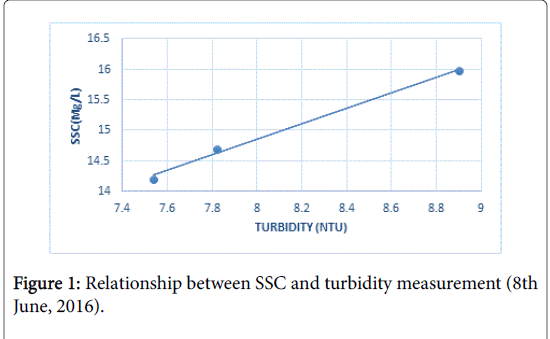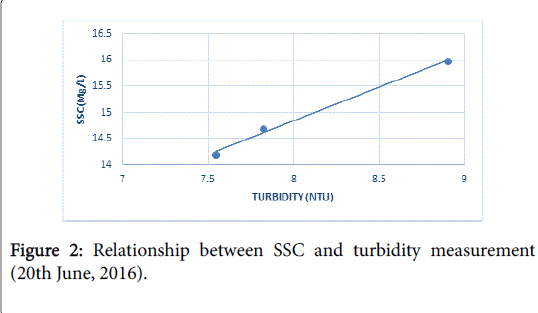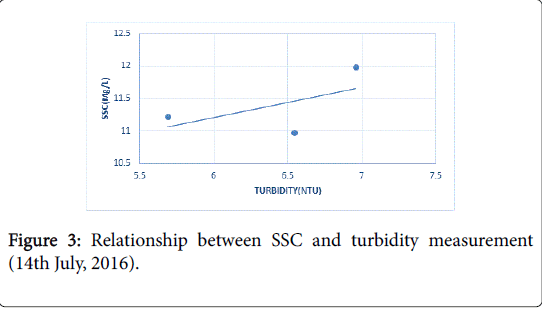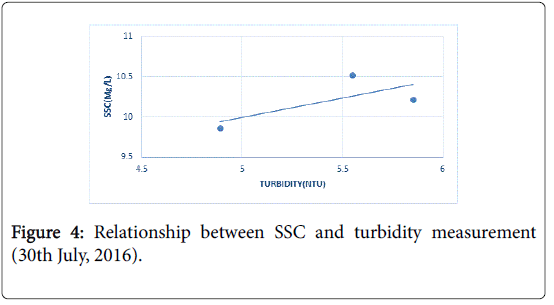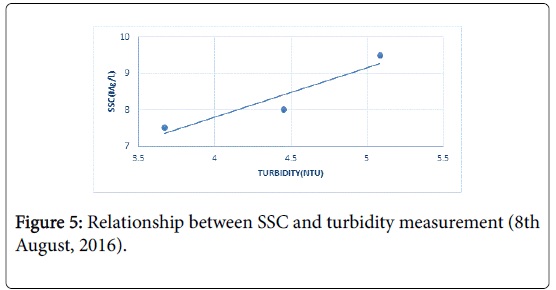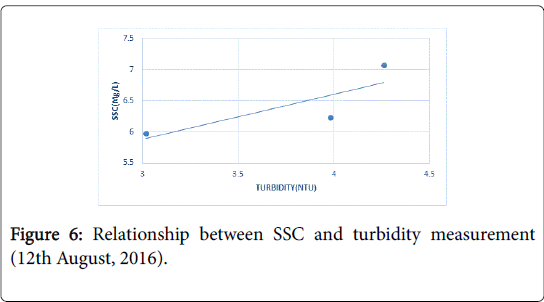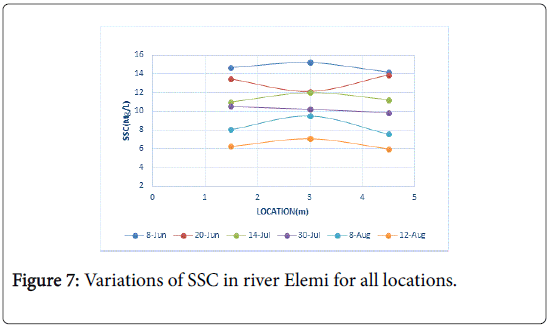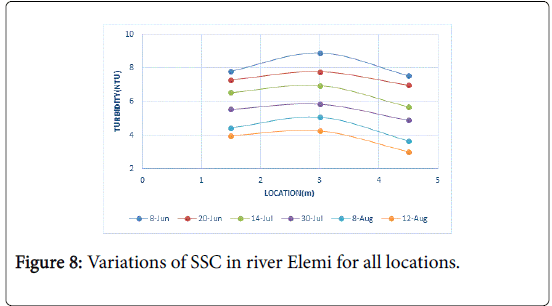Variations of Turbidity (NTU) and Suspended Solid Concentrations (SSC) in Elemi River, Ado-Ekiti, Nigeria
Received: 12-Mar-2018 / Accepted Date: 24-Mar-2018 / Published Date: 30-Jun-2018
Abstract
Changes in contaminant concentration in rivers can be a function of time and location. Seasonal changes greatly influence the parameters of water bodies, which in turn change the water quality characteristics. Monitoring sites during different periods of time can render information about water quality trends. In this paper, the turbidity and suspended solid concentration (SSC) of selected locations in river Elemi are examined for temporal variations. The turbidity levels at the locations exceeded the water quality standards, addressing this requires understanding the SSC which drives the turbidity in the river. Turbidity and SSC were correlated; turbidity increased exponentially with SSC, hence showing positive trends in all the examined locations. The results indicate occurrence of high level of turbidity and SSC in June and July (period of high discharge and runoff). The result provides information requires monitoring both SSC and turbidity (NTU) within the reaches of the river.
Keywords: Suspended solids; Turbidity; Temporal and spatial variations; Elemi river
Introduction
The effect of erosion degradation, negative influences of toxic pollution and human activities all threaten the water quality [1-4].
Turbidity and total suspended solids refer to particles present in the water column. Turbidity and water clarity are both visual properties of water based on light scattering and attenuation. All three parameters are related to particles in the water column, whether directly or indirectly. Turbidity is determined by the amount of light scattered off of these particles. While this measurement can then be used as surrogate to estimate the suspended solid concentration SSC [5-7]. Turbidity does not include any settled solids or bed-load (sediment that “rolls” along the riverbed). In addition, turbidity measurements may be affected by colour dissolved organic matter. While this dissolved matter is not included in SSC measurements, it can cause artificially low turbidity readings as it absorbs light instead of scattering it [8]. SSC is a specific measurement of all suspended solids, organic and inorganic by mass. SSC includes settleable solids, and is the direct measurement of total solids present in a water body. As such, SSC can be used to calculate sedimentation rates [9,10]. Turbidity and SSC are the most visible indicators of water quality. These suspended particles can come from soil erosion, runoff, discharges, stirred bottom sediments or algal blooms. While it is possible for some streams to have naturally high levels of suspended solids, clear water is usually considered an indicator of healthy water. A sudden increase in turbidity in a previously clear body of water is a cause for concern. Excessive suspended sediment can impair water quality for aquatic and human life, impede navigation and increase flooding risks. Monitoring operative of rivers indicate time and seasonal change in water turbidity. Some rivers have good water clarity in dry season but become turbid in wet season with temporal and spatial variations of turbidity within the river reaches [11-15].
Monitoring and analysing this water turbidity variation can help in decision making for river management.
Materials and Method
Three sets of samples were taken from three locations 1.5 m apart on Elemi River at a distance of 5 m from the river bank. The three sets of samples were collected at the same point at different days of 8 June 2016, 20 June 2016, 14 July 2016, 30 July 2016, 8 August 2016 and 12 August 2016. Samples collected into a tight closed container were preserved in order to have samples of good representation for the different types of analysis to be carried out on them [16-18]. Water samples were collected by the combinations of grab, continuous and composite water sampling methods. The grab sampling was used to collect water with a container from the water source, while continuous water sampling occasionally deployed (due to cost) to pump out the water continuously where the grab method application was difficult and the composite involves mixing together all the collected water samples per location for average quality water samples [19-21].
Collected samples were taken to the laboratory for turbidity and suspended solid concentration measurements. Turbidity was measured by the amount of light scattered at angle 90 degree to the incident beam using a calibrated turbidity meter in standard 4000 NTU solution and SSC was measured using filtration method in line with the American Society for Testing & Materials [22].
Results and Discussion
The turbidity and SSC show temporal variations for the three locations examined in river Elemi. From Figures 1-6, the SSC and turbidity relationship indicate positive relationship between SSC and turbidity for all the days measured. On June 8 (Table 1) location 2 recorded the highest value of 15.98 mg/l and 8.90NTU for SSC and turbidity respectively and least value of 14.20 mg/l and 7.52 NTU for SSC and turbidity were recorded in location 3. From Table 1, SSC and turbidity value increases in location 3 with 13.89 mg/l, 7.78 NTU and geometrically decreases in locations 1 (13.45 mg/l, 7.30 NTU) and 2 (12.11 mg/l; 6.96 NTU) respectively on June 20. The SSC value increases with turbidity in location 2 (11.98 mg/l, 6.96 NTU) and decreases in locations 3 (11.23 mg/l, 5.69 NTU) and 1 (10.98 mg/l, 6.54 NTU) for July 14. On July 30, (Table 1), the SSC value increases with turbidity in location 1 (10.52 mg/l and 5.85 NTU) and 2 (10.22 mg/l, 5.55 NTU) and decreases in location 3 (9.86 mg/l, 4.89 NTU). On August 8, the SSC and Turbidity values generally decrease relative to the previous days. SSC value increased with turbidity in location 2 (9.50 mg/l, 5.08 NTU) and 1 (8.02 mg/l, 4.45 NTU) and decreases in location 3 (7.54 mg/l and 3.6 7NTU). The relatively least values of SSC and turbidity was recorded in August 12. SSC values increased with turbidity in location 2 (7.07 mg/l, 4.26 NTU) and 1 (6.23 mg/l and 3.98 NTU) with least value of 5.98 mg/l and 3.02 NTU recorded in location 3 for August 12.
| Date | Parameter | L1 (6.5 m) | L2 (8 m) | L3 (9.5 m) |
|---|---|---|---|---|
| June 8 | SSC (mg/l) | 14.69 | 15.98 | 14.20 |
| Turb (NTU) | 7.82 | 8.90 | 7.52 | |
| June 20 | SSC (mg/l) | 13.45 | 12.11 | 13.89 |
| Turb (NTU) | 7.30 | 6.96 | 7.78 | |
| July 14 | SSC (mg/l) | 10.98 | 11.98 | 11.23 |
| Turb (NTU) | 6.54 | 6.96 | 5.69 | |
| July 30 | SSC (mg/l) | 10.52 | 10.22 | 9.86 |
| Turb (NTU) | 5.85 | 5.55 | 4.89 | |
| August 8 | SSC (mg/l) | 8.02 | 9.50 | 7.54 |
| Turb (NTU) | 4.45 | 5.08 | 3.67 | |
| August 12 | SSC (mg/l) | 6.23 | 7.02 | 5.98 |
| Turb (NTU) | 3.98 | 4.26 | 3.02 |
Table 1: Table showing parameter values for SSC and Turbidity for river Elemi.
Figure 7 shows both temporal and spatial variations of suspended solid concentration for all the days measured. The distribution of SSC as inferred from the figure shows similar trend except for June 20 at location 1, 2, 3 and July 30 at locations 1 and 2, the highest value of SSC was recorded on June 8 at location 2 and the lowest SSC recorded in August 12 at location 3. The result demonstrates a reduction in SSC with time at river Elemi. Similarly, Figure 8 shows the comparative distribution of turbidity for the days measured, the turbidity measures shows similar trends with the SSC, the highest value of turbidity was recorded in June 8 at location 2 while the lowest value of turbidity was recorded in August 12 in location 3. The increase in turbidity and SSC value in June and July is attributed to high rain event with high discharge and runoff which aid resuspension of sediment particle.
Conclusion
Higher values of SSC and turbidity were recorded in June and July due to high rain event with higher discharge to resuspend the sediment particles, and the lower value of the parameters recorded in August due to a reduced rainfall event and lower runoff. The amount of SSC and Turbidity is the key issue that affect river water quality. World Health Organization (2006) recommends that turbidity of drinking water should have less than 5 NTU, preferably less than 1 NTU and ideally below 0.1 NTU, therefore the river is not recommended for drinking during high rainfall event.
References
- Seebacher L (1991) Washington state department of ecology. General Algae Information in Freshwater.
- Wood MS (2014) Estimating suspended sediment in river using acoustic Doppler meters.
- Anderson CW (2005) Turbidity 6.7 in USGS National Field manual for the collection of water-quality data.
- Chang H (2005) Spatial and temporal variations of water quality in the Han River and its tributaries, Seoul, Korea, 1993-2002. Water Air Soil Pollut 161: 267-284.
- Cooke R. Lab 17: Total suspended solids. sanitary biology and chemistry.
- Gao Q (2006) Correlation of total suspended solids and suspended sediment concentration test method. In New Jersey Department of Environmental Protection Division of Science, Research and Technology.
- Hankanson L (2005) The relationship between salinity, suspended solids matter and water clarity in aquatic systems. In The Ecology Society of Japan.
- Kentucky Water Watch (2007) Total Suspended solids and water quality. in river assessment monitoring project. S General Information on Solids. In City of Boulder.
- Mccoy WF, Olson, BH (1985) Relationship among turbidity, particle counts and bacteriological quality with in water distribution lines. Water Res 20: 1023-1029.
- Mosneag SC, Popescu V, Vele D, Neamtu C (2014) Comparative study regarding the quality of surface and ground drinking water obtained from the water from cluj region. Pro-Environ 7: 110-116.
- Nowak DJ, Greenfield EJ (2012) Tree and impervious cover change in us cities. Urban Forest Urban Green 11: 21-30.
- Oiste AM (2014) Groundwater quality assessment in urban environment. Int J Environ Sci Tech 11: 2095-2102.
- Osmond DL, DE Line, JA Gale. Water soil and hydro-environmental decision support system.
- Ozaki H, Le AK, Pham VN, Nguyen VB, Tarao M, et al. (1994) Determining the settling velocity. In Intro to Biochemical Engineering Term Project.
- Perkins C (2014) Spatial and temporal variation in water quality along an urban stretch of the Chattahoochee river and Utoy creek in Atlanta, Georgia State University, USA.
- Pesce, SF Wunderli DA (2000) Use of water quality to verify the impact of Cordoba city (Argentina) on Suqia River. Water res 34: 2915-2926.
- Peters N (2009) Effects of Urbanization on stream water quality in the city of Atlanta, Georgia, USA Hydrol Process 23: 2860-2878.
- Sallis J (2009) Measuring physical activity environments: A brief history. Am J Prev Med 36: S86-S92.
- Sanchez E, Colmenarejo MF, Vicente J, Rubio A, Garcia, et al. (2007) Use of the water quality index and dissolved oxygen deficit as simple indicators of watersheds pollution. Ecol Indic 7: 315-328.
- Singh KP, Malik A, Mohan D, Sinha S (2004) Multivariate statistical techniques for the evaluation of spatial and temporal variations in water quality of Gomti river (India) A case study. Water Res 38: 3980-3992.
- Suarez J, Puertas J (2005) Determination of cod, bod, and suspended solids loads during combined sewer overflow (CSO) events in some combined catchments in Spain. Ecol Eng 24: 199-217.
Citation: Folorunso OP (2018) Variations of Turbidity (NTU) and Suspended Solid Concentrations (SSC) in Elemi River, Ado-Ekiti, Nigeria. J Mater Sci Nanomater 2: 104.
Copyright: ©2018 Folorunso OP. This is an open-access article distributed under the terms of the Creative Commons Attribution License, which permits unrestricted use, distribution, and reproduction in any medium, provided the original author and source are credited.
Select your language of interest to view the total content in your interested language
Share This Article
Recommended Journals
Open Access Journals
Article Usage
- Total views: 5548
- [From(publication date): 0-2018 - Dec 19, 2025]
- Breakdown by view type
- HTML page views: 4577
- PDF downloads: 971

